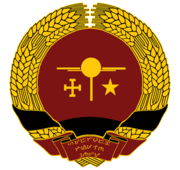Headquarters of the Janpian Union of Revolutionary Forces
| Headquarters of the Janpian Union of Revolutionary Forces | |
|---|---|
 Front Facade of the Headquarters | |
| General information | |
| Architectural style | Haussman Architecture |
| Address | Paliskaya Street, Fort Kalinka, Union District, Kalingrad City 2200 |
| Current tenants | People's Marshal, Annie Natya Anya |
| Construction started | April 14, 3E6 |
| Completed | October 19, 3E8 |
| Owner | Janpian Union of Government Workers' Party |
| Website | |
| www.jurf.gov.jur | |
The Headquarters of the Janpian Union of Revolutionary Forces (Janosche Unschon no Revolutsiya Arusye no Kutschel) is a building located in Fort Kalinka. It serves as the general staff headquarters and operations of the four Revolutionary branches namely the Janpian Union of Revolutionary Army (JURA), Janpian Union of Revolutionary Navy (JURN), Janpian Union of Revolutionary Air Force (JURAF), and the Janpian Union of Revolutionary Missileers (JURM). The building has many metonyms, such as "Stables" or simply "Grand Barracks", which are mostly used as codenames among the Revolutionary Forces.
The current JURF Headquarters Building was constructed in the 6th year of the 3rd era, mainly to serve as a barracks house for the Fort Kalinka Imperial Garrison. The building's design and construction coincided with Fort Kalinka modernization at that time, where the facilities of the fort was revitalized to fit in newer cannons as well as the necessary accomodation for gunpowder, projectiles, and soldiers. Additionally, the revitalization further thickened it's brick walls, making it hard to be penetrated by small sized cannons and other projectiles. The most recent renovation of the building was after the [[4th Era Revolution, in which the compound was expanded, and a stronger steel structure was built over inside the facade.
History
First Building
During the Schonghuescha Era, the site used to be a wooden stable inside a Toriijo Kalinka, a fort under the Janoschpe Clan. It was constructed in a traditional Janpian Architecture with a smoothen maple wood, and was constructed with no nails applied. Old reports also stated that it had a feeding area for the horses, as well as a drinking station taken from the nearby Munschen River.
Second Building
During the colonial eras, the wooden stable was replaced with a simple brick building meant to serve as a barracks house for the Marquesan soldiers. The design was a 1-story barracks house made to accommodate up to 80 to 120 soldiers on bunks, complete with a rest house and gun armory to provide them easy access to their weapons in case of a night attack.
Following Janpian independence, the Imperial Government has edicted to expand the barracks with the addition of a second floor to accomodate more soldiers, with the 1st floor being designated for other functionary use. Furthermore, the building was also expanded with an east and west wing, making it a compound to also accomodate officers. Additional changes were also made such as the walls being further thickened to withstand small projectiles and flying fragments.
Contemporary
The barracks house sustained damage during the Janpian Revolution , with the east wing as well as its main entrance being completely destroyed by Revolutionary bombs. After the war, the newly established Janpian Union of Government Workers' Party quickly renovated the building and designated it as the headquarters of the Revolutionary Forces. The facade was restored albeit its internals was heavily altered with a steel structure, as well as additional changes to accomodate all three branches at that time by expanding underground. In this way, the structure still retains its old historical identity, and at the same time, being able to take in new functions and other requirements.






